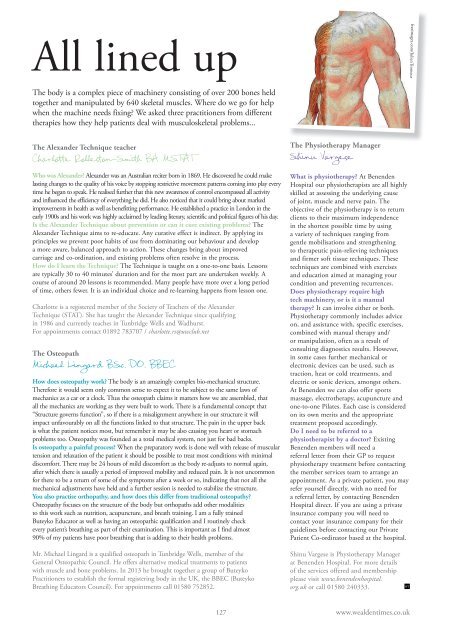Wealden Times | WT163 | September 2015 | Education supplement inside
Wealden Times - The lifestyle magazine for the Weald
Wealden Times - The lifestyle magazine for the Weald
Create successful ePaper yourself
Turn your PDF publications into a flip-book with our unique Google optimized e-Paper software.
All lined up<br />
freeimages.com/JulienTromeur<br />
The body is a complex piece of machinery consisting of over 200 bones held<br />
together and manipulated by 640 skeletal muscles. Where do we go for help<br />
when the machine needs fixing? We asked three practitioners from different<br />
therapies how they help patients deal with musculoskeletal problems...<br />
The Alexander Technique teacher<br />
Charlotte Rolleston-Smith BA MSTAT<br />
Who was Alexander? Alexander was an Australian reciter born in 1869. He discovered he could make<br />
lasting changes to the quality of his voice by stopping restrictive movement patterns coming into play every<br />
time he began to speak. He realised further that this new awareness of control encompassed all activity<br />
and influenced the efficiency of everything he did. He also noticed that it could bring about marked<br />
improvements in health as well as benefitting performance. He established a practice in London in the<br />
early 1900s and his work was highly acclaimed by leading literary, scientific and political figures of his day.<br />
Is the Alexander Technique about prevention or can it cure existing problems? The<br />
Alexander Technique aims to re-educate. Any curative effect is indirect. By applying its<br />
principles we prevent poor habits of use from dominating our behaviour and develop<br />
a more aware, balanced approach to action. These changes bring about improved<br />
carriage and co-ordination, and existing problems often resolve in the process.<br />
How do I learn the Technique? The Technique is taught on a one-to-one basis. Lessons<br />
are typically 30 to 40 minutes’ duration and for the most part are undertaken weekly. A<br />
course of around 20 lessons is recommended. Many people have more over a long period<br />
of time, others fewer. It is an individual choice and re-learning happens from lesson one.<br />
Charlotte is a registered member of the Society of Teachers of the Alexander<br />
Technique (STAT). She has taught the Alexander Technique since qualifying<br />
in 1986 and currently teaches in Tunbridge Wells and Wadhurst.<br />
For appointments contact 01892 783707 / charlotte.rs@uwclub.net<br />
The Osteopath<br />
Michael Lingard BSc. DO. BBEC<br />
How does osteopathy work? The body is an amazingly complex bio-mechanical structure.<br />
Therefore it would seem only common sense to expect it to be subject to the same laws of<br />
mechanics as a car or a clock. Thus the osteopath claims it matters how we are assembled, that<br />
all the mechanics are working as they were built to work. There is a fundamental concept that<br />
“Structure governs function”, so if there is a misalignment anywhere in our structure it will<br />
impact unfavourably on all the functions linked to that structure. The pain in the upper back<br />
is what the patient notices most, but remember it may be also causing you heart or stomach<br />
problems too. Osteopathy was founded as a total medical system, not just for bad backs.<br />
Is osteopathy a painful process? When the preparatory work is done well with release of muscular<br />
tension and relaxation of the patient it should be possible to treat most conditions with minimal<br />
discomfort. There may be 24 hours of mild discomfort as the body re-adjusts to normal again,<br />
after which there is usually a period of improved mobility and reduced pain. It is not uncommon<br />
for there to be a return of some of the symptoms after a week or so, indicating that not all the<br />
mechanical adjustments have held and a further session is needed to stabilize the structure.<br />
You also practise orthopathy, and how does this differ from traditional osteopathy?<br />
Osteopathy focuses on the structure of the body but orthopaths add other modalities<br />
to this work such as nutrition, acupuncture, and breath training. I am a fully trained<br />
Buteyko Educator as well as having an osteopathic qualification and I routinely check<br />
every patient’s breathing as part of their examination. This is important as I find almost<br />
90% of my patients have poor breathing that is adding to their health problems.<br />
Mr. Michael Lingard is a qualified osteopath in Tunbridge Wells, member of the<br />
General Osteopathic Council. He offers alternative medical treatments to patients<br />
with muscle and bone problems. In 2013 he brought together a group of Buteyko<br />
Practitioners to establish the formal registering body in the UK, the BBEC (Buteyko<br />
Breathing Educators Council). For appointments call 01580 752852.<br />
The Physiotherapy Manager<br />
Shinu Vargese<br />
What is physiotherapy? At Benenden<br />
Hospital our physiotherapists are all highly<br />
skilled at assessing the underlying cause<br />
of joint, muscle and nerve pain. The<br />
objective of the physiotherapy is to return<br />
clients to their maximum independence<br />
in the shortest possible time by using<br />
a variety of techniques ranging from<br />
gentle mobilisations and strengthening<br />
to therapeutic pain-relieving techniques<br />
and firmer soft tissue techniques. These<br />
techniques are combined with exercises<br />
and education aimed at managing your<br />
condition and preventing recurrences.<br />
Does physiotherapy require high<br />
tech machinery, or is it a manual<br />
therapy? It can involve either or both.<br />
Physiotherapy commonly includes advice<br />
on, and assistance with, specific exercises,<br />
combined with manual therapy and/<br />
or manipulation, often as a result of<br />
consulting diagnostics results. However,<br />
in some cases further mechanical or<br />
electronic devices can be used, such as<br />
traction, heat or cold treatments, and<br />
electric or sonic devices, amongst others.<br />
At Benenden we can also offer sports<br />
massage, electrotherapy, acupuncture and<br />
one-to-one Pilates. Each case is considered<br />
on its own merits and the appropriate<br />
treatment proposed accordingly.<br />
Do I need to be referred to a<br />
physiotherapist by a doctor? Existing<br />
Benenden members will need a<br />
referral letter from their GP to request<br />
physiotherapy treatment before contacting<br />
the member services team to arrange an<br />
appointment. As a private patient, you may<br />
refer yourself directly, with no need for<br />
a referral letter, by contacting Benenden<br />
Hospital direct. If you are using a private<br />
insurance company you will need to<br />
contact your insurance company for their<br />
guidelines before contacting our Private<br />
Patient Co-ordinator based at the hospital.<br />
Shinu Vargese is Physiotherapy Manager<br />
at Benenden Hospital. For more details<br />
of the services offered and membership<br />
please visit www.benendenhospital.<br />
org.uk or call 01580 240333.<br />
127 www.wealdentimes.co.uk


















